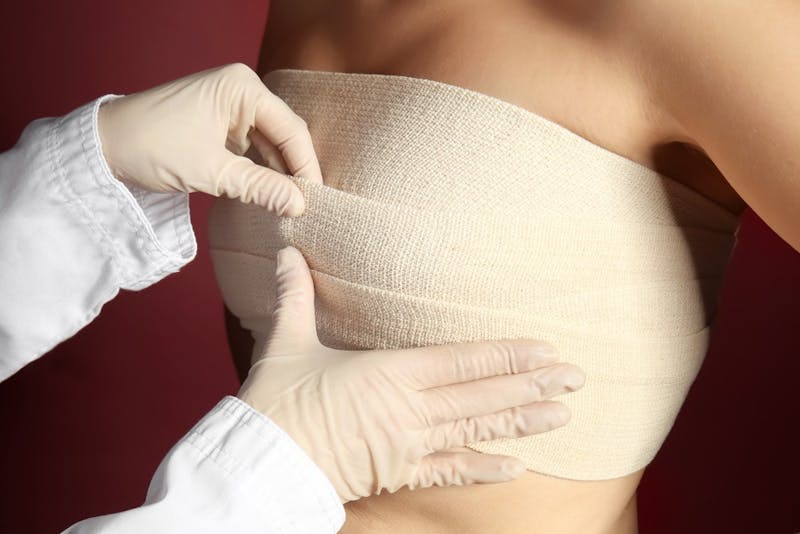How to decide: implant vs. flap breast reconstruction surgery?

Breast reconstruction surgery after a mastectomy or breast removal operation is more about achieving the natural feel or look of breasts, restoring the breast mounds, and achieving symmetry than just enhancing the volume or shape. Even though both options—implant surgery and flap surgery—to reconstruct the breast can provide excellent cosmetic results, it is important to decide in close collaboration with your plastic surgeon.
However, most often, flap reconstruction, meaning reconstruction of breasts using the patient’s body tissue (also known as autologous tissue reconstruction or tissue-based reconstruction), either immediate or delayed reconstruction, is recommended. However, using a tissue flap option cannot always be the case for breast reconstruction after mastectomy, as there are several personal and medical reasons requiring assessment prior to recommending a specific option. Evaluating one’s medical and problem status is crucial when deciding the right option. In addition, the type of breast cancer and body type also play a pivotal role when deciding the reconstruction option, aiming to achieve aesthetic results!
Breast reconstruction with implants is undoubtedly easier, safer, and result-centric, leaving minimal scars and having shorter downtime. But, in some cases, tissue flap procedures can be used with a breast implant if more volume is needed.
What is breast reconstruction using a flap procedure?
A tissue flap procedure (autologous tissue reconstruction), or tissue-based reconstruction, is the method of reconstructing or rebuilding the shape of your breasts after cancer treatment (mastectomy or breast removal surgery). To rebuild the breast shape, a tissue flap surgery involves harvesting the tissue from other body parts (called donor areas), such as the tummy, back, thighs, or buttocks. The tissue flap gives a more natural look and feel and has no risks of infection or side effects, as the patient’s tissue is used for reshaping or reconstructing the breasts. One must note that tissue flaps will change like any other tissue in your body. However, weight changes, aging, or lifestyle changes are crucial in affecting outcomes after a certain time. Sometimes, they may require a second surgery to meet the desired surgical goals.
Advantages:
lFlap surgery gives a more natural feel and look because the patient’s body tissue is used for reconstruction.
lStay warm at a normal body temperature.
lFlap surgery is free from the risks of rupture or wear and tear issues, and side effects are not the case with tissue-based reconstruction.
lHave white blood cells that can fight infections in your breast.
lIf more volume is required, flap tissue reconstruction can sometimes be combined with implants.
Limitations:
lIn general, flaps require more surgery and have a longer recovery timeline than breast implants.
lFlap reconstruction leaves two surgical marks, one from where tissue is harvested, such as the abdomen, back, thighs, or buttocks, and the second one on the reconstruction sites (breasts) to fulfill the breast reconstruction job.
lSome women may report donor site problems, such as abdominal bulging, weakness, or contour irregularities, such as dimpling of the skin.
When is flap reconstruction surgery performed?
Many patients get flap reconstruction surgery to rebuild their breasts immediately after breast removal surgery, known as immediate reconstruction. However, one may require a second surgery later on to improve the shape, volume, and contour of reconstructed breasts that weight fluctuations, aging, or other lifestyle changes can impact. One must note that they may not be recommended for immediate flap reconstruction surgery if they have inflammatory breast cancer or need radiation therapy!
In most cases, flap reconstruction surgery can be performed as a separate procedure post breast removal surgery, known as delayed reconstruction, when a patient might want more time to decide if breast reconstruction is the right choice in their specific case.
Breast reconstruction with implants:
A breast implant is the most common form of breast reconstruction. In reconstructive plastic surgery, implants are inserted into your chest to enhance the size of your breasts. Breast implants involve a silicone shell filled with either saline (sterile saltwater) or silicone (gel). Patients may choose to receive breast implants following the mastectomy in response to restoring the breasts post-cancer treatment. A patient must have good physical health and realistic expectations and should be mentally ready to consider breast implants after breast removal surgery.
Advantages:
l Reconstruction with an implant is easy, safe, hassle-free, and gives a longer-lasting result.
lIt causes less scarring and has minimal downtime compared to flap surgery.
lThe reconstructed breasts with implants do not change in size if you gain weight.
lIt gives a reasonable shape for small and medium-sized breasts.
Limitations:
lSilicone implants require monitoring for rupture with an imaging study every few years.
lImplants are less mobile and feel colder than a flap reconstruction.
lImplants may not be recommended if a patient has had radiotherapy or if their chest wall skin is not healthy.
(The author, Dr. Karishma Kagodu, is a plastic and cosmetic surgeon.)
Source: Pynr
The content published on the website is for creating awareness and educating purposes only. This shall not be considered as a substitute for professional advice or prescription. The results mentioned on the website may vary from person to person as each case is different.

